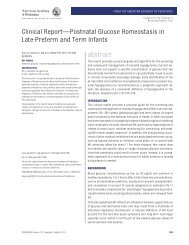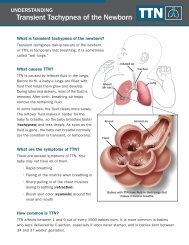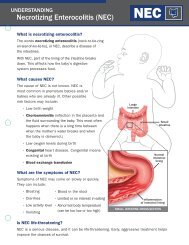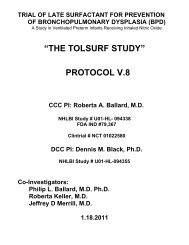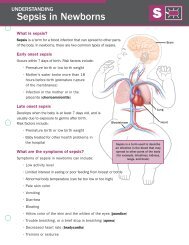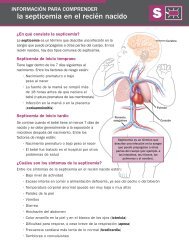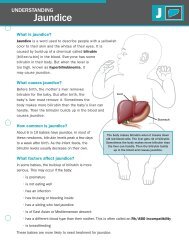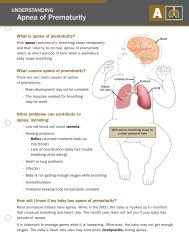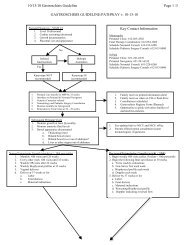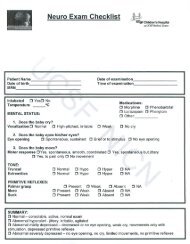NICU-Resident-Manual..
NICU-Resident-Manual..
NICU-Resident-Manual..
- No tags were found...
Create successful ePaper yourself
Turn your PDF publications into a flip-book with our unique Google optimized e-Paper software.
E. HYPERKALEMIA(Central Serum Potassium 6.5 mEq/l or >) is a medical emergency that requiresclose patient observation, continuous cardiac monitoring, and measurement of serumpotassium levels. Treatment is indicated when serum potassium is greater than 7 mEq/l.Etiology of Hyperkalemia in Neonates• Factitious (most common): Hemolyzed blood from heel stick, thrombocytosis.Send repeat sample STAT before starting treatment, unless EKG changes indicatehyperkalemia.• Decreased removal of potassium: Acute renal failure, positive potassium balancein premature infants during the first days of life, adrenal failure in CAH and medications(Captopril).• Increased load of potassium: Hemoloysis, IVH, hematoma, excess potassiumadministration.• Redistribution: Elevated potassium, secondary to metabolic acidosis and sepsis,NEC, and medications (Digoxin).Evaluation of HyperkalemiaDetermination of etiology and management: Electrolytes, BUN, creatinine, plateletcount, blood gases, ionized calcium, total calcium, and magnesium levels. EKG changesprogress with increasing potassium level: peak T-waves, prolonged PR interval, loss of Pwave, widening QRS, sign wave QRST, first degree AV block, ventricular dysrhythmia and,finally, asystole.Treatment of HyperkalemiaHyperkalemia with dehydration should respond to fluid resuscitation.• Immediately change to an IV solution without potassium. If on gentamicin, hold dose,pending evaluation of renal status, and gentamicin trough levels. The effects ofhyperkalemia can be worsened by hypocalcemia and hypomagnesemia.Hyperkalemia with Cardiac Changes• With cardiac monitoring, give 100 mg/kg/dose (1 ml/kg/dose) IV of 10% calciumgluconate or 20 mg/kg/dose (0.2 ml/kg/dose) of 10% calcium chloride over 10minutes. This will decrease myocardial excitability and prevent cardiac arrhythmias.May repeat calcium dose in 10 minutes, if abnormal cardiac changes persist.Administration of calcium does not lower serum potassium levels.• If patient is acidotic, give sodium bicarbonate, 1-2 mg/kg IV over 10-20 minutes.Inducing alkalosis will drive potassium into cells. Correct respiratory acidosis firstbefore administering sodium bicarbonate.• Give insulin to assist driving potassium into the intracellular fluid compartment. Ifinfant is normoglycemic, administer insulin and glucose together as a bolus to preventhypoglycemia. The ratio should be 1 unit of insulin to 4 gm of glucose given as a



